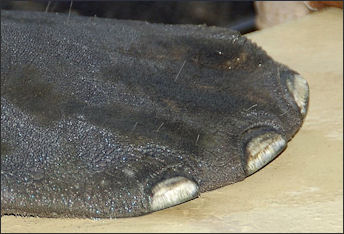DUGONGS AND MANATEES

Manatee Dugongs and manatees are large aquatic mammals. Sometimes called seacows, they favor areas with sea grass, which they graze on like cows, hence their nickname. What makes them unique compared to other sea mammals is that are herbivores. Whales, dolphin and seals are all carnivores.
Dugongs and manatees were among the first mammals to take to the water. Fossils of dugong-like creatures with hind legs have been dated to 50 million years ago, a time when mammals were beginning to spread out after the age of the dinosaurs. Dugongs and manatees are believed to be distant relatives of elephants. Some species have useless toenails at the ends of their flippers and elephant-like molars. Fossil manatees show gradual reduction of their hind limbs.
Dugongs and manatees, some say, gave birth to mermaid legends in an age when sailors who had been at sea way too long mistook them for beautiful fish-tailed women. After laying eyes on a manatee, Christopher Columbus wrote: "They are not as beautiful as they are painted, although to some extent they have a human appearance in the face." In recent times someone described them as "over-stuffed seagoing sofas with movable covers for tails.”
Dugongs and manatees belong to an order call Sirenia. Sirenians get their name from the Spanish word for sirens (“sirenas”, after the Sirens with seductive songs from Homer’s “Odyssey”). They are distant relatives of elephants. Another sirenian, the Stellar's sea cow, was hunted to extinction in the Bering Sea area. It was 25 feet long and weighed 6,000 pounds. It was discovered in 1731 and was extinct by 1768.
Species of Dugong and Manatee
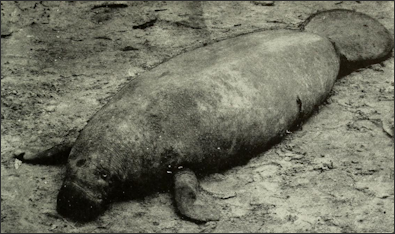
West African manatee Manatees are found primarily in freshwater. They are found in the Amazon, rivers and swamps in Florida, and some African rivers. In the West Indies and Central America they can be found in estuaries, swamps and coastal areas.
Dugongs live in marine environments in coastal areas in the southwest Pacific and Indian Ocean in an area that stretches from Red Sea and Persian Gulf in the west through Sri Lanka, Thailand and Indonesia to Japan, Australia and the Solomon Islands in the east.
There are three species of manatees and one species of dugong. 1) the West Indian manatee (residing in the Caribbean and Atlantic and coastal waters between Florida and Brazil); 2) the Amazonian manatee (residing in the Amazon basin); 3) the West African Manatee; and 4) the dugong. Manatees are found in the Atlantic and Caribbean area. Dugongs are found in the Pacific and Indian oceans. The manatees found in Florida are a subspecies of the West Indian manatees. Once one showed up near the Statue of Liberty in East River of New York.
Dugong and Manatee Characteristics
Manatee foot Dugongs and manatees have a fat, sausage-like, mostly hairless body with a broad with a spade-shaped tail and short paddle-like front flippers. They have no hind flippers but do have vestigial pelvic bones. Two species of manatee have three or four nails on each flipper, vestiges of their four-legged past. Florida manatees can live to be 50 years old, weigh 454 kilograms to 907 kilograms and reach a lengths of three meters.
In deep water, dugongs and manatees swim around somewhat like seals in slow motion, moving along with downward sweeps from their massive tails.. In shallow water use their front flippers for balance and to walk on the bottom.
Many dugongs spend time in both freshwater and saltwater. Their skin can be an inch thick and is covered with shallow pits and is regarded as their first line of defense against injury. They have an extremely long gut with a side extension called a caesum. They need a large digestive system to process large amounts of low-protein, low-calorie food but they do not have a specialized chambered stomach like a ruminant. It takes about a week for manatee to digest its food.
Dugongs surface for air every one or two minutes when feeding and every 10 to 15 minutes when resting. They generally only surface for a few seconds to exhale and inhale and then swim around underwater. Their bones are very dense compared to other mammals and this helps them maintain buoyancy in shallow water. After a fracture, excess bone around the break is not reabsorbed as is usual with mammals. This may help to strengthen their otherwise brittle bones.
Dugong and Manatee Senses
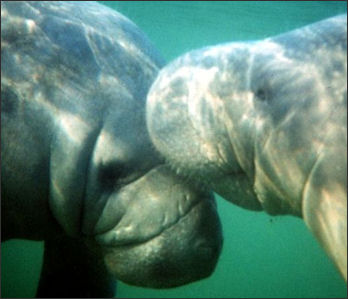 Dugongs and manatees have bristle-covered snouts, two circular disks on their forehead that act as nostrils, tiny, deep-set eyes, and no external ears. The thick hairs on their face — called vibrissa — are very sensitive to touch. About 600 vibrissa are situated on a manatee’s mouth. They relay information to the brain about what the manatee touches and senses in the water.
Dugongs and manatees have bristle-covered snouts, two circular disks on their forehead that act as nostrils, tiny, deep-set eyes, and no external ears. The thick hairs on their face — called vibrissa — are very sensitive to touch. About 600 vibrissa are situated on a manatee’s mouth. They relay information to the brain about what the manatee touches and senses in the water.
About 3,000 vibrissa are located on the bodies of manatees. Researchers speculate they may help the animal navigate and even hear. Each vibrissa sits in a blood-filled pocket. Movement affects the amount of fluid in the pockets and changes and other information from the pockets is passed on to receptors which relay the information to the brain.
Dugongs and manatees spend much of their time in murky water and don't have very good eyesight. Their hearing is better than humans in some ranges. They have a permanent smile on their face like dolphins and probably have a poor sense of smell. They keep their nostrils closed with valves when they are underwater and only open them a few seconds after they surface. Individual dugongs and manatees are recognizable by a combination for size, shape and scars.
Dugongs and manatees have only six vertebrae in their neck, fewer than other mammals. They have peg-like molar teeth which they use to grind the grasses they feed on. As these teeth wear down they slowly migrate along the jaw and are replaced by new ones which emerge at the back of the mouth and slowly move forward.
Dugong and Manatee Feeding Behavior
 Dugongs and manatees live mostly in warm, shallow water and spend most of their time grazing on water plants. Their life is slow and easy. They nap a lot between meals. The plants they feed on need sunlight and live near the ocean surface so the animals tend to stay close to the surface and do not need to dive to any great depths. They are so big and strong that predators do not attack them and the shallow waters they hang out in are generally not places that sharks go.
Dugongs and manatees live mostly in warm, shallow water and spend most of their time grazing on water plants. Their life is slow and easy. They nap a lot between meals. The plants they feed on need sunlight and live near the ocean surface so the animals tend to stay close to the surface and do not need to dive to any great depths. They are so big and strong that predators do not attack them and the shallow waters they hang out in are generally not places that sharks go.
Dugongs and manatees consume 5 to 10 percent of their body weight every day, which can work out to about 200 pounds of food. Dugongs feed mostly on sea grass. They also feed on algae. Often they feed at night. Florida manatees eat water hyacinths, freshwater grass, wild celery, milfoil, and bottom-growing vegetation. They consume huge quantities of aquatic plants and are regarded as invaluable cleaners of clogged waterways. Captive dugongs and manatees are often fed lettuce and cabbage supplemented with vitamins and minerals.
Dugongs and manatees have large lip pads. They suck in plants and tuck them into their mouths with their bristles. They also use their front flippers to push food into their mouths. Their upper lips are disk-shaped well muscled and so dexterous that can use them to grasp leaves, rip them up and put them in their mouths and to grasp the rhizomes of sea grass from the sandy sea bottom. Browsing takes up about a forth of their time.
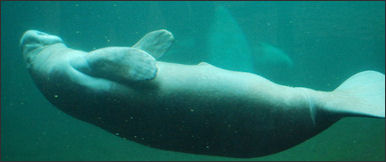
Dugongs in Australia live in small herds and feed on defined pastures, primarily consuming young shoots which are more nutritious than old growth.
Dugong and Manatee Behavior
Some manatee and dugongs are loners. Other hang out in small herds that play, graze and doze together.
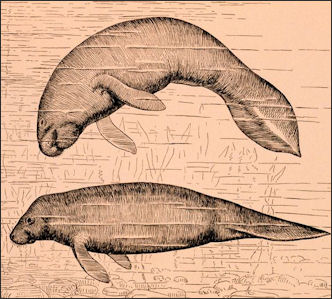 Dugongs make a wide variety of sounds. When alarmed they emit squeals, chirps, screams or squeaks. Under normal conditions they make short calls in a high or low frequency that sound like “pee, pee” or long calls that sound like “peeeee.” When they are most active they call about once every second. They call less when they are not active and make a wide variety of sounds in other situations. Dugongs and manatees do not appear to use echolocation like dolphins to locate objects under water.
Dugongs make a wide variety of sounds. When alarmed they emit squeals, chirps, screams or squeaks. Under normal conditions they make short calls in a high or low frequency that sound like “pee, pee” or long calls that sound like “peeeee.” When they are most active they call about once every second. They call less when they are not active and make a wide variety of sounds in other situations. Dugongs and manatees do not appear to use echolocation like dolphins to locate objects under water.
Dugongs are generally very docile and slow moving. They can also be very playful and curious. The often nibble on, kiss, nuzzle, nudge, butt, embrace and groom each other and occasionally pull on the fins and chew on the diving suits of snorkelers. Even though, dugongs are found alone in the open sea these behaviors show they are very social animals.
Dugongs and manatees normally cruise around at a speed of two and four miles per hour and can reach speeds of 20mph with quick up and down thrashes of their tail. They tend to stick to certain areas but migrate to warmer waters when water temperature drops. Algae often grows all over dugongs. They have been observed lying upside down and scratching their backs on the bottom of sea.
It was once thought that manatees and dugongs were dim-witted brutes. They have the smallest brain to body ratio of any mammal and are of one of the few large mammals that has virtually no ridges or wrinkles on their brains — often viewed as a sign of intelligence. But many experiments it turns out they performs just as well as dolphins. For example they can distinguish between different colors and geometric shapes. It is believed that the reason their body is so proportionally large to their brain is because they need a large body to control their body temperature and they have few predators to fear.
Dugong and Manatee Breeding Behavior
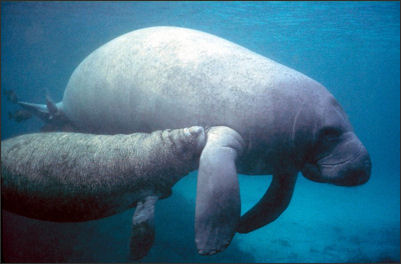
Manatee with calf Females became sexually mature as early as four years of age and generally produce a single calf or sometimes two every two or three years. Females in estrus often accept the advances of several males. A single female has been observed being followed by 17 males although usually the large bulls and able to scare off the younger males.
During the mating season dugongs in Australia. males awake from the stupor of the docile life and start slapping the surface of the water with their tails. This sometimes serves as a signal to head to deep water. Females do not all become fertile at once, so the males pursue each female as she becomes receptive. The males fight by thrashing their tails and lunging their bodies at each other. The male that prevails mates with the female face to face. Manatee mating sometimes resemble a gang rape.
The gestation period for dugongs and manatees is around 14 months. Describing the birth of a manatee, Jesse White wrote in National Geographic, "In a single explosive contraction an elastic, grayish thing, about 12 inches in diameter appeared. During each successive contraction it grew bigger and more oblong. [About two hours later]...the amniotic sac burst. Minutes later, in a frenzy of movement and an extreme, flexed contraction, the baby was born tail first. With his mother beneath him, the infant swam to the surface, making loud, high-pitched cries.” [Source: Jesse R. Whaute, National Geographic, September 1984]

dugong Infants weigh about 60 pounds and reach a length of about 4 feet at birth. They suckle from the thumb-size teat on their mother’s armpit while their mother lays at the surface so she and her baby can breath. The mother often holds her baby in her flippers in a human-like way. It is this position, some say, that gave birth to mermaid legend.
Dugong and manatee young stay with their mothers about one or two years after birth before heading off on their own. It is not uncommon for mothers to nurse a yearling and an older calf but rarely at the same time.
Endangered Dugongs
Dugongs are rare and elusive. About 100,000 dugongs live in coastal areas in Australia, Asia, the Middle East and Africa, with about 80,000 of them in Australia. In coastal areas of the Pacific, Indian and Atlantic oceans rivers once inhabited by manatee and dugongs are now have none.
Dugongs have traditionally been killed for their meat, which is said to taste like pork, and the strong leather produced by their skin. They have been hunted and harpooned for centuries by a number of indigenous cultures, most famously by Aboriginal tribes in islands off northern Australia.
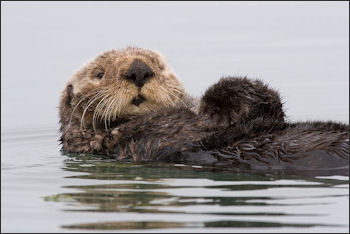
Sea otter Dugongs are threatened by loss of habitat, hunting and injuries from motorboat propellers. Because they often swim near the surface in some places dugongs they have been badly injured, scarred and killed by propellers from motor boats.
In Florida manatees show be thriving as they have no natural predators and they have a plentiful food supply. Up to 80 manatees are killed by boats in Florida every year. Manatees are hurt so often by boats partly they have trouble hearing the low frequency noised made by the engines. They are also killed cold stress, red tides, flod fate and kick accidents
Manatees gave been successfully raised in captivity and released in the wild Born-Free-style. In 2006 a manatee was spotted in the Hudson River in New York. It was the northernmost sighting of a manatee ever. No one could explain what had happened. Some scientists suspected that U.S. Navy sonar was maybe to blame.
Sea Otters
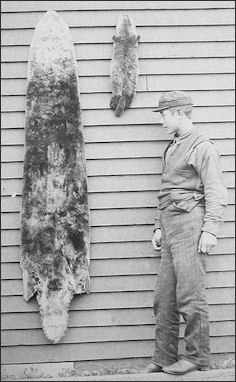
sea otter pelts Sea otters are 120 to 140 centimeters long and weigh between 20 and 40 kilograms. They have the densest fur of any mammal. Air trapped in the fibers keeps them warm and allows them to float on the surface. Daily grooming is necessary for upkeep. Because their fur is so durable, warm and valuable sea otters were nearly hunted to extinction.
Sea otters live in shallow coastal waters, often hanging around kelp beds. They like to float lazily on the sea with their arms folded across their chest. They usually eat in this position. Mothers also nurse their young in this position.
Sea otters dive to the bottom of the sea and gather shellfish and mollusks. Often the arrive at the surface with a rock which they use bash open the shell.
Abalones are a favorite food of sea otters and the source of nacre, or mother of pearl, a thick iridescent material. Sea otters cradle the shells on their chests and crack the shells open with rocks.
Baby sea otter are born one at a time at sea. They are virtually inseparable for their mothers the first six months of their lives but remain a the surface while their mothers dive for food.
In the early 2000s, the populations of sea otters suddenly plummeted in waters off Alaska as killer whales began seeking them as prey because their main food sources of seals and sea lions had declined. The number of sea otters n the Aleutians declined from 85,000 in 1990 to 8,500 in the early 2000s.
The sea otter is what drew early Russian explorers to eastern Siberia, the Bering Sea and Alaska. In the 19th century otters pelts were as valuable as sable and mink. The first Russian explorers were Cossacks, an ethnic group from the Black Sea known for their fierceness. The tsars also hired them as their elite front line soldiers.∞
Image Sources: Wikimedia Commons, National Oceanic and Atmospheric Administration (NOAA)
Text Sources: New York Times, Washington Post, Los Angeles Times, Times of London, Yomiuri Shimbun, The Guardian, National Geographic, The New Yorker, Time, Newsweek, Reuters, AP, Lonely Planet Guides, Compton’s Encyclopedia and various books and other publications.
Last updated January 2012

